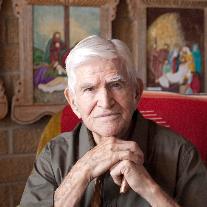- Date Of Birth: May 19, 1919
- Date Of Death: May 31, 2010
- State: New Mexico
Ramón Montes was born May 19, 1919, on West Manhattan St in Santa Fe, before his family had electricity or plumbing, and through the assistance of a “partera”/midwife. Like all of our parents or grandparents of his generation, his life experiences are broad and deep. As a child he had many jobs to help support his family. Speaking only Spanish, he sold newspapers on the plaza, starting at the age of seven, and helped out in his parents’ little grocery store in the front room of their house. During the 1920s he was a local sandlot baseball player, and he had great memories of sitting in the plaza, as radio speakers from the top of the Capitol Pharmacy broadcast the World Series to the large crowd below. A CCC “boy” and WPA member during the Depression, he assisted in building roads and bridges in northern NM. During that time he became a boxer and won a Golden Gloves medal at a boxing match in El Paso. At twenty years of age he built his first, of many, adobe houses, this one on Montez Place. Shortly afterwards he moved his younger brothers and sisters into that house, when they all became orphaned. He raised them and made sure they made they were fed, went to school and church, and made their First Holy Communion. (Later, his two children grew up in that house, until ages ten and seven, when he built his current house.) He became a heavy machine gunner and fought during one of the last major battles of WWII in March 1945—the capturing of the Ludendorff Bridge in the German town of Remagen. Saving this bridge allowed the allied armies to cross the River Rhine into the industrial heartland of Germany, and shortened the war by blocking Hitler’s army from escaping to the south. This resulted in saving the lives of many of our troops. The fierce battle was later made into a movie, “The Bridge at Remagen”. He lost much of his hearing as the result of firing his gun for three solid days against German planes that were desperately trying to destroy the bridge to prevent the allies from crossing it. He earned the Bronze Metal, the Purple Heart, and the French Jubilee of Liberty Medal. A week after his return from the war, he walked over the hills from Santa Fe to the Santuario in Chimayo in his combat boots, holding the rosary he carried during the war, thankful to be home. He was an electrician for Pond’s Electric for thirty-five years and worked in many of Santa Fe’s historic buildings, including being the first of a team to install electricity in the Oldest House. A pacifist, who chose to paint or carve animals rather than hunt them, he has been a life-long santero artist. He was forever saying, “Life is beautiful, if you don’t weaken.” He says his positive outlook throughout his life was formed in those early years growing up in the town of his heritage, Santa Fe.
Born to Roberto Montes and Aurelia C de Baca, his siblings who preceded him were Rafael, Sigfredo, Sylvia, Robert and Consuelo. Those who survive him are Arsenio, Joe and Alice. He lost the love of his life, his wife of sixty years, Emma Jaramillo Montes, of Rancho de Chimayo, in 2006. He will be greatly missed by his children María Móntez-Skolnik (Harry) and Rey Móntez and close nephews, Joe Sisneros, Tony Sisneros, who were always there for him in time of need, and many cherished nephews, nieces and friends who love him. His greatest admiration came from his two grandsons who adored him and considered him their hero and guiding light, Benjamin Ramón Móntez Skolnik and Zachary Alejandro Móntez Skolnik, who lived with him every entire summer of their childhood and who will carry his life story into the next generation.
